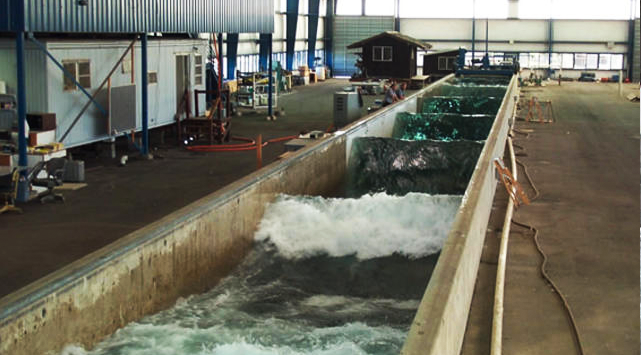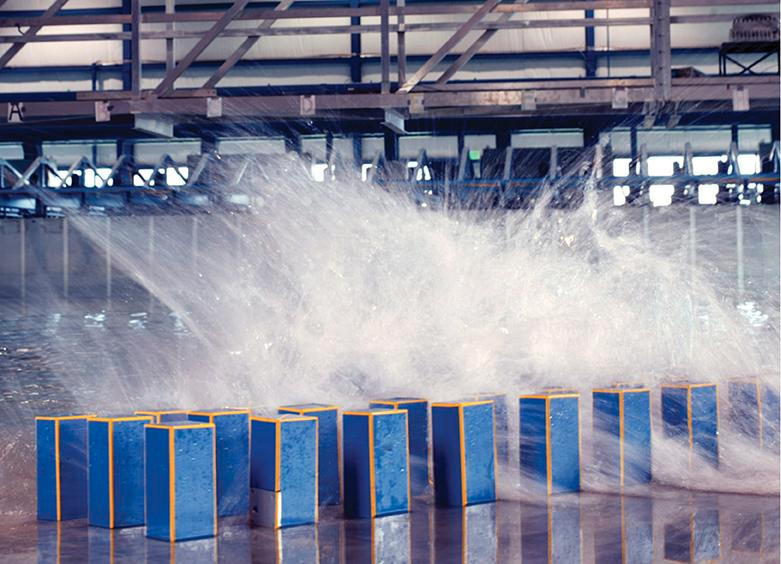The primary goal of the CWST-EF is to be an integral part of NHERI, providing access to unique large-scale experimental test facilities, expert advice on experimental design, and implementation of procedures to achieve research objectives of the Users, high quality data to researchers with traceable standards, efficient scheduling, and cost-effective use of the facility, upholding health and safety standards for the staff and visiting personnel.
The Experimental Protocol incorporates the Test Plan, which consists on a series of activities to be executed during the study, and its associated sequence of events. Careful and open planning of physical model testing is extremely important to accomplish the desired objectives, to comply with the schedule program, and to be cost-effective. Planning of physical model tests is a continuous process, and requires a deep understanding of the processes to be simulated as well as the techniques applied. This is part of the collective experience of the CWST-EF team, including the previous experience with NEES operations 2004-2014. With clearly identified research objectives, the scope of the experimental work can be outlined, and the associated activities, milestones and durations can be planned beforehand.
Experiment design is one of the key activities of the Test Plan. The design of an experiment will follow a general protocol that has been established over time through use of the NEES Tsunami Facility 2004-2014. Because of the uniqueness of research, the experimental setup and testing procedures will need to be customized to each User. At the same time, certain aspects of the experimental design are fairly routine, and the CWST-EF will communicate these in advance to the Users. Experiment design includes the layout of the model in the facility, model construction procedures and restrictions, instrument layout, sequence of activities, and may identify or impose certain limitations or capabilities of the testing program. On many occasions, numerical modelling may be used as a complement for the experimental design, where boundary and scale effects may be identified so countermeasures can be implemented, or preliminary understanding and assessment on the processes involved can be obtained to identify the location, number and typology of instruments to be deployed for a given test configuration or environmental conditions. By these means, instrument location and data will be optimized for the project.
The CWST-EF aims to help Users with technical advice and support to researchers at any stage of the proposal preparation, test planning and design, model construction and instrumentation, and data analysis. Researchers interested in using the facilities can get additional information and guidance about the facility capabilities by contacting the HWRL Director Pedro Lomonaco.


a. During Proposal Preparation
Researchers and potential users of the NHERI CWST-EF are encouraged to contact the facility staff as soon as the consideration of experiments is part of the proposal. The EF will provide support and guidance; will identify opportunities and limitations, with the primary goal of achieving the objectives of the research while maintaining the feasibility of the project and excellence in the results.
It is highly recommended to the Researcher sharing as much information regarding the objectives and scope of the experiments, so the selection of the experimental resource, instrumentation, characteristics of the tests specimen, budget, and schedule, can be identified at an early stage. The NHERI CWST-EF will keep all the shared information confidential to protect the Researcher intellectual property.
The NHERI CWST-EF will also provide a Letter of Commitment (LOC) to the researcher, according to the requirements of NSF.
The NHERI CWST-EF does not necessarily have to be involved in the proposal as co-PI, although this will be analyzed on a case by case basis.
b. After the Grant is Awarded
As soon as the Researcher is notified of the award, it is recommended to contact the EF, allowing the detail planning and scheduling of the experiments, as well as the involvement of the NCO.
The NHERI CWST-EF will support the Researcher in the detailed design of the test specimen, wave and water level conditions, as well as the layout in the flume or the basin. Application of numerical models, undisturbed wave tests (in the absence of the model), and procurement of necessary equipment and instruments, will commence as early as possible, keeping in mind the main objectives of the study, and preferences of the Researcher about timing and schedule, in accordance to the current schedule of testing.